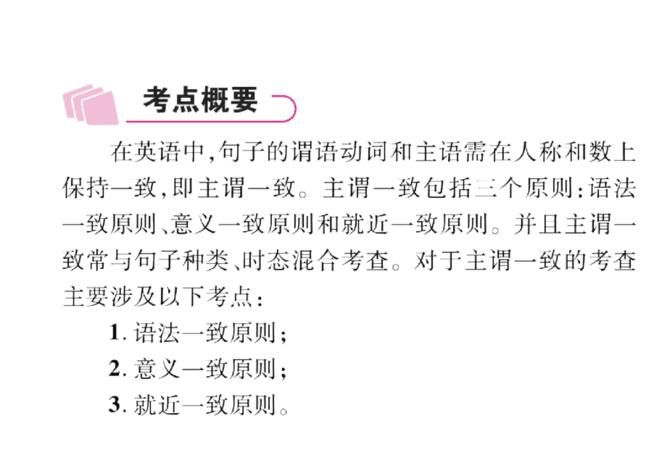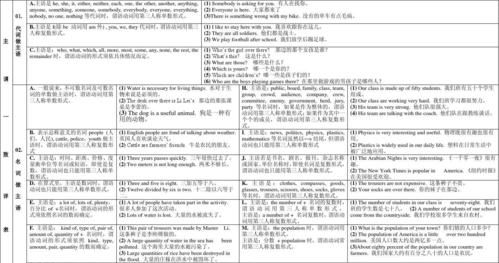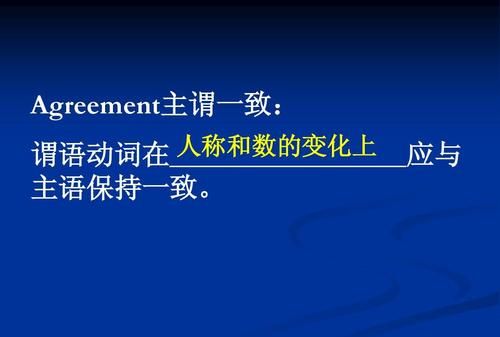本文目录
主谓一致问题英语
主谓一致是指: 1) 语法形式上要一致,即单复数形式与谓语要一致。 2) 意义上要一致,即主语意义上的单复数要与谓语的单复数形式一致。 3) 就近原则,即谓语动词的单复形式取决于最靠近它的词语, 一般来说,不可数名词用动词单数,可数名词复数用动词复数。 There is much water in the thermos. 但当不可数名词前有表示数量的复数名词时,谓语动词用复数形式。 e.g. Ten thousand tons of coal were produced last year. Large quantities of water are needed. In western countries, mountains of rubbish are thrown away each day. 1 并列结构作主语时谓语用复数 Reading and writing are very important. 注意: 当主语由and连结时,如果它表示一个单一的概念,即指同一人或同一物时,谓语动词用单数,and 此时连接的两个词前只有一个冠词。 The iron and steel industry is very important to our life. 典型例题 The League secretary and monitor ___ asked to make a speech at the meeting. A. is B. was C. are D. were 答案B. 注:先从时态上考虑。这是过去发生的事情应用过去时,先排除A.,C.。本题易误选D,因为The League secretary and monitor 好像是两个人,但仔细辨别, monitor 前没有the,在英语中,当一人兼数职时只在第一个职务前加定冠词。后面的职务用and 相连。这样本题主语为一个人,所以应选B。 2 主谓一致中的就近原则 1) 当there be 句型的主语是一系列事物时,谓语应与最邻近的主语保持一致。 There is a pen, a knife and several books on the desk.. There are twenty boy-students and twenty-three girl-students in the class. 2)当either… or… 与neither… nor,连接两个主语时,谓语动词与最邻近的主语保持一致。 如果句子是由here, there引导,而主语又不止一个时,谓语通常也和最邻近的主语一致。 Either you or she is to go. Here is a pen, a few envelopes and some paper for you. 3 谓语动词与前面的主语一致 当主语后面跟有with, together with, like, except, but, no less than, as well as 等词引起的短语时,谓语动词与前面的主语一致。 The teacher together with some students is visiting the factory. He as well as I wants to go boating. 4 谓语需用单数 1) 代词each和由every, some, no, any等构成的复合代词作主语,或主语中含有each, every, 谓语需用单数。 Each of us has a tape-recorder. There is something wrong with my watch. 2) 当主语是一本书或一条格言时,谓语动词常用单数。 The Arabian Night is a book known to lovers of English. 《天方夜谭》是英语爱好者熟悉的一本好书。 3) 表示金钱,时间,价格或度量衡的复合名词作主语 时,通常把这些名词看作一个整体,谓语一般用单数。(用复数也可,意思不变)。 Three weeks was allowed for making the necessary preparations. Ten yuan is enough. 5 指代意义决定谓语的单复数 1) 在代词what, which, who, none, some, any, more, most, all等词的单复数由其指代的词的单复数决定。 All is right. (一切顺利。) All are present. (所有人都到齐了。) 2) 集体名词作主语时,谓语的数要根据主语的意思来决定。如family, audience, crew, crowd, class, company, committee等词后用复数形式时,意为这个集体中的各个成员,用单数时表示该个集体。 His family isn't very large. 他家不是一个大家庭。 His family are music lovers. 他的家人都是音乐爱好者。 但集合名词people, police, cattle, poultry等在任何情况下都用复数形式。 Are there any police around? 3)有些名词,如variety, number, population, proportion, majority 等有时看作单数,有时看作复数。 A number of +名词复数+复数动词。 The number of +名词复数+单数动词。 A number of books have lent out. The majority of the students like English. population的谓语动词形式与表语一致,一般来说与分数,百分数连用时,谓语动词用复数。 6 与后接名词或代词保持一致 1) 用half of, part of, most of, a portion of 等词引起主语时,动词通常与of后面的名词,代词保持一致。 Most of his money is spent on books. Most of the students are taking an active part in sports. 2) 在一些短语,如 many a 或 more than one 所修饰的词作主语时,谓语动词多用单数形式。但由more than… of 作主语时,动词应与其后的名词或代词保持一致。 Many a person has read the novel. 许多人都读过这本书。 More than 60 percent of the students are from the city.百分之六十多的学生都来自这个城市 7 在定语从句中主语是关系代词who , that , which , 谓语动词的数应与先行词的数一致。 注意:在“one of +复数名词+ who/that/which”引导的定语从句中,从句谓语的单复数取决 于one前是否有the (only)、the very。如果有,从句的谓语动词用单数,如没有the only, 就用复数形式。 This is one of the most interesting questions that have been asked. He was the only one of the s在定语从句中主语是关系代词who , that , which , 谓语动词的数应与先行词的数一致。 累死了~~~ 嘿嘿不用谢 不客气~~~~

主谓一致问题英语
主谓一致有许多原则,概括起来不外乎三种一致原则,即:语法形式一致;概念一致(语言内容上一致);毗邻一致(谓语动词的单复数形式和紧位于其前的主语一致)。
另外,根据代词应该在人称、数、性等方面与所指的词保持一致,还有指代一致。
一、语法形式一致
1、单数主语、单个动词不定式、动名词短语以及句子作主语,谓语动词要用单数形式。复数主语,用and或both…and连接的动词不定式短语、动名词短语以及主语从句作主语,谓语动词则用复数形式。例如:
Serving the people is my great happiness. 为人民服务是我最大的幸福。
Whether we’ll go depends on the weather. 我们是否去要取决于天气的好赖。
What I think and what I seek have been fairly reflected in my paper.
我所思考的和我所寻求的都在这个论文中体现了出来。
2、由as well as, with, along with, like, together with, rather than, except, but, including, accompanied by, plus, besides, in addition to, no less than 等引起的结构跟在主语后面,不能看作是并列主语,该主语不受这些词组引导的插入语的影响,主语如是单数,其谓语动词仍然用单数形式。例如:
The reading course book, plus its reference books, is helpful to college students.
教材加上参考书对大学学生是非常有益的。
The man together with his wife and children sits on the sofa watching TV.
那个人和他妻儿老小坐在沙发上看电视。
3、有些代词只能指单数可数名词,当它们在句子中作主语时,尽管在意义上是多数,谓语动词仍要用单数形式。这类代词有either, neither, each, one, the other, another, somebody, someone, something, anyone, anything, anybody, everyone, everything, everybody, no one, nothing, nobody等。例如:
Neither likes the friends of the other. 两人都不喜欢对方的朋友。
Everything around us is matter. 我们周围的所有东西都是物质。
4、当and连结的两个名词是指同一个人或同一件事,and后的名词前没有冠词,谓语动词应该用单数形式;在and后面的名词前有冠词,谓语就用复数形式。例如:
The bread and butter is served for breakfast. 早饭供应黄油面包。
The bread and the butter are on sale. 正在出售黄油和面包。
5、当one of, a portion of, a series of, a species of, a chain of 结构作主语时,谓语动词要用单数形式。例如:
One of those students has passed the examination. 这些学生只有一个考试及格了。
A series of pre-recorded tapes has been prepared for language laboratory use.
为语音课提前准备了一系列录音磁带。
6、由one and a half + 复数名词或the majority of + 名词作作主语时,谓语动词视名词的单复数形式而定。例如:
The majority of the damage is easy to repair. 大部分的损坏品都容易修理。
7、plenty of, half of, a lot of, lots of, heaps of, loads of, scads of等 + 可数与不可数名词作主语时,不可数名词的谓语只用单数,可数名词的谓语视可数名词的单复数而定。例如:
There is plenty of water in the pail. 桶里还有好多水。
There are plenty of eggs in the box. 箱子里有好多鸡蛋。
8、由more than one (或more than one + 单数名词),many a + 单数名词作主语,谓语动词要用单数形式。例如:
More than one student has passed the examination. 不止一个学生通过了这次考试。
Many a boy learns to swim before he can read. 许多孩子在认字前就学会了游泳。
9、如果名词词组中心词是“分数或百分数 + of + 名词”,谓语动词的单、复数形式取决于of后的名词或代词的单、复数形式。例如:
Over three-quarters of the land has been reclaimed. 四分之三多的土地已经收回了。
Two-thirds of the people present are against the plan.
到场的三分之二的人都反对这个计划。
10、定语从句谓语动词的单复数形式应与先行词一致。例如:
He is one of the men who were chosen to represent the group.
被选出来代表该组的人他是其中之一。
“Keep cool” is the first of the rules that are to be remembered in an accident.
“镇静”是事故发生时应当牢记的第一条原则。
二、概念一致(语言内容上一致)
1、有些集合名词如crowd, family, team, orchestra(管弦乐队), group, government, committee, class, school, union, firm, staff, public等,它们作主语时,谓语动词的数要根据语言内容而定。如果它们作为一个集体单位时,动词用单数形式,如就其中的各个成员来说,则谓语用复数形式。例如:
His family is going to move. 他准备搬家。
His family are very well. 他家人身体都好。
2、有些表示总体意义的名词,形式上是单数,而意义上却是复数,谓语动词要用复数形式,如people, police, militia, cattle, poultry(家禽)等。例如:
The police are searching for a tall dark man with a beard.
警察正在搜寻一位肤色黝黑、长胡子的高个子男人。
3、有些名词形式上是复数,而意义上却是单数。如news, means, works.还有许多以ics结尾的学科名称,如economics, physics, mechanics, politics等,它们作主语时,谓语动词要用单数形式。例如:
Politics is a complicated business. 政治学是一门复杂的东西。
Here is the news. 下面播送新闻。
4、用and连接的单数主语,前面有each, every, many a, no等修饰时,谓语动词要用单数形式。复数主语与each连用时,应不受each的影响,谓语动词仍用复数形式。例如:
Every boy and girl is treated in the same way.
每个男孩、女孩都是以同样的方式对待的。
Many a boy and many a girl has seen it. 很多姑娘小伙子都见过。
The old workers and the young each have their own tools.
青老年工人都各自有自己的工具。
5、表示重量、度量、衡量、价值的复数名词作主语,谓语动词常用单数形式。例如:
Twenty miles is a long way to walk. 二十里地可是个不近的路程。
Three pints isn’t enough to get me drunk. 三品脱还不至于把我灌醉。
the +形容词作主语时,如主语指的是一类人,谓语动词用复数形式;如果指的是单个人或抽象概念,谓语动词用单数形式。例如:
The departed was a good friend of his. 死者是他的一位好友。
三、毗邻一致(就近原则)
1、由连词or, neither…or, either…or, not only … also, nor等连接的并列主语,谓语动词的单复数形式按毗邻一致的原则,与贴近它的主语一致。例如:
Either you or he is no telling the truth. 不是你就是他没讲真话。
Not only the switches but also the old wiring has been changed.
不仅开关,连那些老化了电路都已经更换了。
2、在there be 的结构中,谓语动词的单复数形式一般也采取就近原则。例如:
There is a desk and four benches in the office. 办公室有一张桌子,四条长凳。
There are two chairs and a desk in the office. 办公室有两把椅子一张桌子。
四、代词的指代一致
指代一致是指句中的代词应该在人称、数、性等方面与所指的词保持一致。也是考试中的一个常考点。
1、当everyone, everybody, no one, nobody, anyone, anybody, someone, somebody等作主语时,相应的代词一般采用单数形式。例如:
If anyone calls, tell him I’ll be back later. 如果有人找我,就说我一会回来。
Everyone thinks he is the center of universe. 每个人都认为自己是宇宙的中心。
2、由neither … nor, not only … but also, either … or, not … but, or等连结的并列主语,其后的附加疑问部分主语用复数代词。例如:
Neither you nor I am wrong, are we? 你我都没错,对吧?
Both Tom and Jack came, didn’t they? 汤姆和杰克都来了,对不对?
3、当句子的主语是one, 并要在句子中多次出现时,一般用第三人称单数代词来代替后面将出现的one或one’s;当one在句子中泛指人时,在反意疑问句中也可用you来代替。例如:
One should never blame his friends even his friends committed some careless mistakes.
当朋友犯了疏忽的小错时不要老指责朋友的过失。
One can’t be too careful, can you (one)? 一个人无论怎么样小心都不为过,对不对?

英语主谓一致题目及答案解析
l、当中心词为度量、距离、价格等复数名词的时候,谓语动词则采用单数形式。如:Two miles is a short distance。
2、在如manya+单数名词;each…and each…组后面,谓语动词仍然用单数形式。如:Many a student makes the same mistake。
3、当主语后面跟由with,together with,but,along with,like.in addition to,as well as,as much as,rather than,except等连接的词组时,其谓语动词的形式依主语的单复数形式而定。如:Statistics as well asphysics always causes mealo to fheadaches。在这里,谓语cause的形式就要依据主语statistics,而不用考虑aswellas后面加的另外一个名词。学科的名词都要用单数谓语动词,所以应该是causes. 相关例题:
Every policeman and fireman_______on the alert。
A.have been B.wasC.are D.were
这道题目的知识点正是上文中提到过的第二点,在each…andeach…,every…and every…,no…andno…之后的谓语动词应该采取单数的形式,所以正确答案应该是B,每一个警察和火警人员都保持警戒状态。
我的朋友前几天在奥威斯发展大厦29层进行辅导的,他和我说他的英语口语有明显提高语法方面也不再混乱了,你不妨去试一下。

英语主谓一致语法总结
主谓一致
主谓一致是指:
1) 语法形式上要一致,即单复数形式与谓语要一致。
2) 意义上要一致,即主语意义上的单复数要与谓语的单复数形式一致。
3) 就近原则,即谓语动词的单复形式取决于最靠近它的词语,
一般来说,不可数名词用动词单数,可数名词复数用动词复数。
There is much water in the thermos.
但当不可数名词前有表示数量的复数名词时,谓语动词用复数形式。
e.g. Ten thousand tons of coal were produced last year.
Large quantities of water are needed.
In western countries, mountains of rubbish are thrown away each day.
1 并列结构作主语时谓语用复数
Reading and writing are very important.
注意: 当主语由and连结时,如果它表示一个单一的概念,即指同一人或同一物时,谓语动词用单数,and 此时连接的两个词前只有一个冠词。
The iron and steel industry is very important to our life.
典型例题
The League secretary and monitor ___ asked to make a speech at the meeting.
A. is B. was C. are D. were
答案B. 注: 先从时态上考虑。这是过去发生的事情应用过去时,先排除A.,C.。本题易误选D,因为The League secretary and monitor 好像是两个人,但仔细辨别, monitor 前没有the,在英语中,当一人兼数职时只在第一个职务前加定冠词。后面的职务用and 相连。这样本题主语为一个人,所以应选B。
2 主谓一致中的靠近原则
1) 当there be 句型的主语是一系列事物时,谓语应与最邻近的主语保持一致。
There is a pen, a knife and several books on the desk..
There are twenty boy-students and twenty-three girl-students in the class.
2)当either… or… 与neither… nor, 连接两个主语时,谓语动词与最邻近的主语保持一致。 如果句子是由here, there引导,而主语又不止一个时,谓语通常也和最邻近的主语一致。
Either you or she is to go.
Here is a pen, a few envelopes and some paper for you.
3 谓语动词与前面的主语一致
当主语后面跟有with, together with, like, except, but, no less than, as well as 等词引起的短语时,谓语动词与前面的主语一致。
The teacher together with some students is visiting the factory.
He as well as I wants to go boating.
4 谓语需用单数
1) 代词each和由every, some, no, any等构成的复合代词作主语,或主语中含有each, every, 谓语需用单数。
Each of us has a tape-recorder.
There is something wrong with my watch.
2) 当主语是一本书或一条格言时,谓语动词常用单数。
The Arabian Night is a book known to lovers of English.
<<天方夜谭>>是英语爱好者熟悉的一本好书。
3) 表示金钱,时间,价格或度量衡的复合名词作主语 时,通常把这些名词看作一个整体,谓语一般用单数。(用复数也可,意思不变。)
Three weeks was allowed for making the necessary preparations.
Ten yuan is enough.
5 指代意义决定谓语的单复数
1) 在代词what, which, who, none, some, any, more, most, all等词的单复数由其指代的词的单复数决定。
All is right. (一切顺利。)
All are present. (所有人都到齐了。)
2) 集体名词作主语时,谓语的数要根据主语的意思来决定。如family, audience, crew, crowd, class, company, committee等词后用复数形式时,意为这个集体中的各个成员,用单数时表示该个集体。
His family isn't very large. 他家不是一个大家庭。
His family are music lovers. 他的家人都是音乐爱好者。
但集合名词people, police, cattle, poultry等在任何情况下都用复数形式。
Are there any police around?
3)有些名词,如variety, number, population, proportion, majority 等有时看作单数,有时看作复数。
A number of +名词复数+复数动词。
The number of +名词复数+单数动词。
A number of books have lent out.
The majority of the students like English.
6 与后接名词或代词保持一致
1) 用half of, part of, most of, a portion of 等词引起主语时,动词通常与of后面的名词,代词保持一致。
Most of his money is spent on books.
Most of the students are taking an active part in sports.
2) 在一些短语,如 many a 或 more than one 所修饰的词作主语时,谓语动词多用单数形式。但由more than… of 作主语时,动词应与其后的名词或代词保持一致。
Many a person has read the novel. 许多人都读过这本书。
More than 60 percent of the students are from the city.百分之六十多的学生都来自这个城市。

以上就是关于主谓一致要考虑时态 ,主谓一致问题英语的全部内容,以及主谓一致要考虑时态吗 的相关内容,希望能够帮到您。

